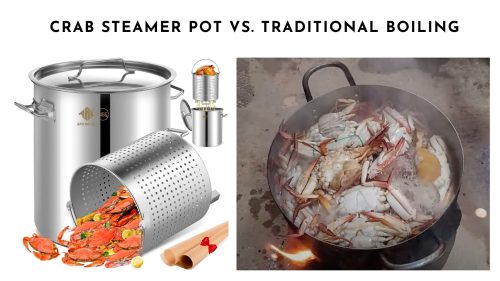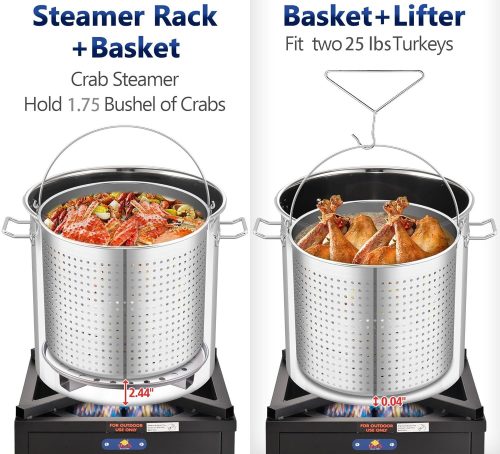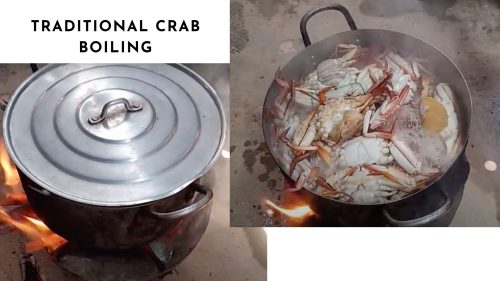Sea crab meat is delicious and enjoyed by seafood enthusiasts around the world. When it comes to cooking crab, two primary methods dominate the kitchen scene: using a crab steamer pot or opting for the traditional boiling method. Both approaches have their advantages and disadvantages, and the choice between them depends on your preferences and culinary goals. In this article, our chef will guide you into the world of crab cooking, comparing the two methods to help you decide which one is the best fit for your next crab feast.
Let’s get start!

Crab Steamer Pot vs. Traditional Boiling
1. Cooking Crab with Steamer Pot: The Pros & Cons
In the modern world, using steamer pot method to cook crabs has become more and more popular among the fishermen, cooks, and the chefs at various restaurant. Yet, while it has a lot of advantages, it also has some disadvantages comparing to the traditional boiling.

Advantages of Using a Crab Steamer Pot
Here are the best parts about the use of the crab steamer pot:
- Flavor Retention: Steaming crabs using a crab steamer pot is renowned for preserving the natural sweetness and delicate flavors of the crab meat. The gentle heat of steam ensures that the crab’s taste remains intact, resulting in a succulent and flavorful meal.
- Even Cooking: Steaming crabs in a dedicated crab steamer pot offers even and consistent cooking. Each crab is exposed to the same level of heat, ensuring that they reach perfection simultaneously.
- Healthier Option: Steaming is a healthier cooking method compared to boiling, as it does not involve submerging the crabs in water. This reduces the risk of losing water-soluble nutrients and minerals into the cooking liquid.
- Easy Seasoning: Steaming allows for easy incorporation of seasonings. You can infuse your crabs with a variety of flavors, from traditional Old Bay seasoning to zesty lemon and garlic, resulting in a more customized and delicious dining experience.
Disadvantages of Using a Crab Steamer Pot
For bad side, there is not much about the pot. Yet, we figure out two that may bothering you.
- Specialized Equipment: To steam crabs, you’ll need a dedicated crab steamer pot, which may not be a staple in every kitchen. Acquiring this equipment is an additional investment. So, you decide if it is worth it or not.
- Time-Consuming: Steaming crabs generally takes a bit more time than boiling, which can be a drawback if you’re looking for a quick meal.
Traditional Boiling of the Crabs: The Pros & Cons

If you are not cooking crab regularly, we don’t really recommend you to invest in buying another cookware. Any available pot or pan in your kitchen will help in our traditional way. Here is your advantage:
Advantages of Traditional Boiling
- Simplicity: Boiling crabs is a straightforward and fuss-free method that requires minimal equipment. All you need is a large pot, water, and a heat source.
- Speed: Boiling is typically faster than steaming. If you’re in a hurry to satisfy your crab cravings, boiling might be the way to go.
- Accessibility: Most kitchens are equipped with the essentials for boiling crabs, making it a convenient option when you want to cook crab on short notice.
Disadvantages of Traditional Boiling
After the advantages, here are the advantages of the tradition way:
- Flavor Loss: Boiling crabs can lead to flavor loss as some of the crab’s natural juices may leach into the cooking water. While you can use seasoned boiling water to mitigate this, some flavor may still be lost.
- Risk of Overcooking: Boiling crabs requires precise timing to avoid overcooking. A few extra minutes in boiling water can turn tender crab meat tough.
- Less Control: Unlike steaming, where you can easily add and control seasonings, boiling requires you to season the cooking water, which may result in uneven flavor distribution.
Making the Choice: Steaming vs. Boiling
The choice between a crab steamer pot and traditional boiling depends on your culinary preferences and priorities. So here what you can do:
- Choose steaming if: You prioritize flavor retention and are willing to invest in specialized equipment. If you enjoy customizing the flavors of your crab with seasonings, steaming is an excellent choice.
- Choose boiling if: You’re looking for a quick and straightforward method, don’t want to invest in additional equipment, or prioritize speed over flavor retention.
In the end, both methods can yield delicious crab dishes. It’s all about your personal preference and the dining experience you want to create. Whichever method you choose, one thing is certain: a well-cooked crab feast is bound to satisfy your seafood cravings and leave your taste buds dancing with delight.